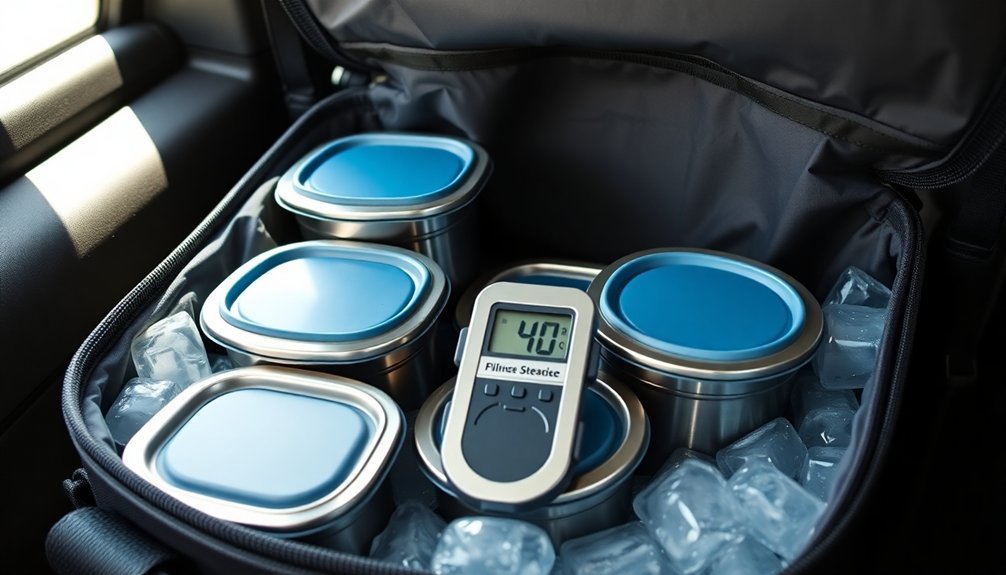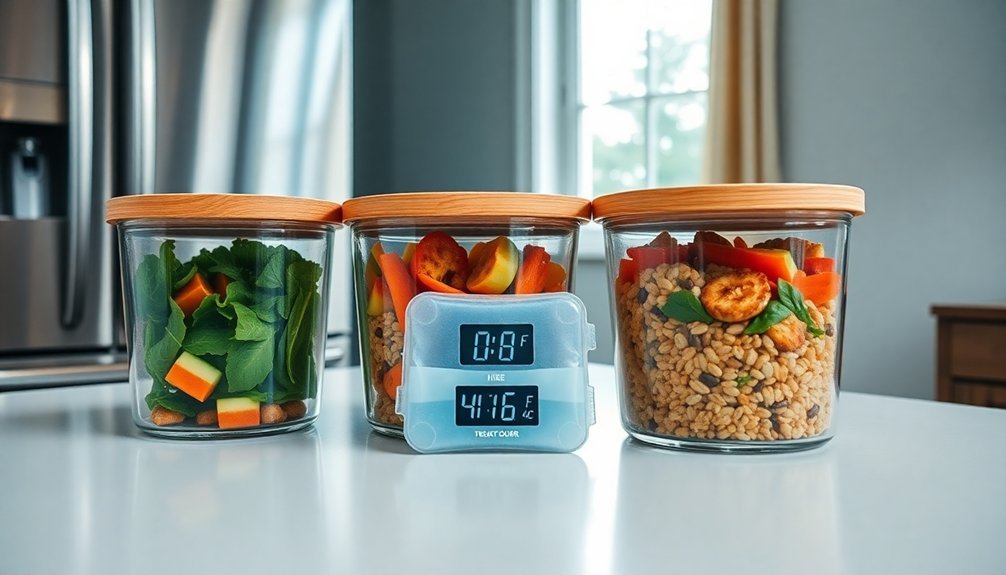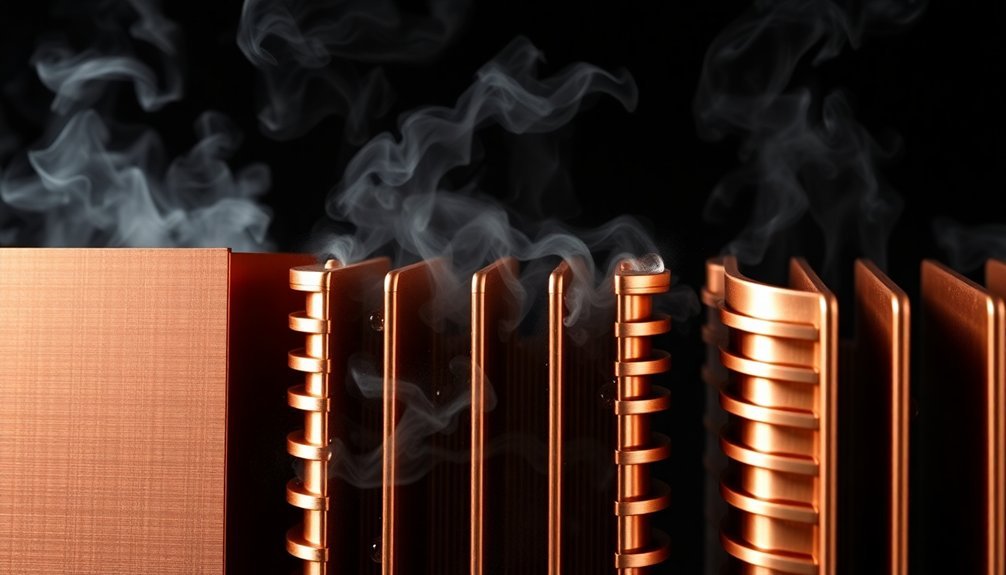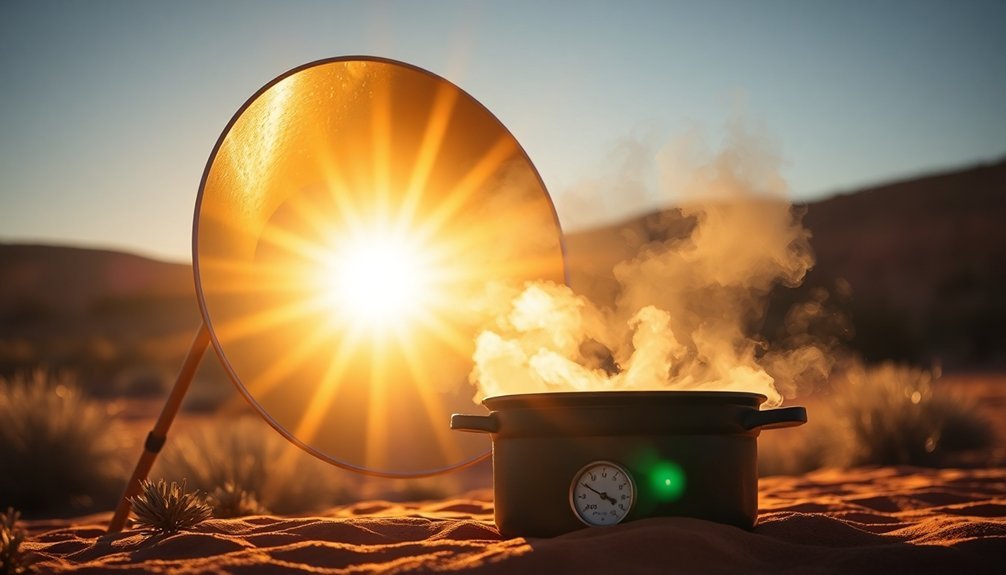When preparing meals using solar cooking methods, you'll need to follow strict food safety guidelines to prevent foodborne illness. Keep hot foods above 140°F and cold items below 40°F using reliable thermometers and insulated containers. Choose heat-resistant materials like glass or stainless steel with tight-fitting lids, and always sanitize your containers before use. Store raw ingredients separately from cooked foods, and use color-coded cutting boards to prevent cross-contamination. Monitor food temperatures every 2 hours and quickly cool leftovers to 40°F or below. If you're planning to explore sun-based cooking techniques, these fundamental safety practices will set you up for success.
Essential Food Safety Equipment

The right food safety equipment makes all the difference in preventing foodborne illness and maintaining proper storage conditions.
You'll need high-quality storage containers with tight-fitting lids that resist moisture and vapor, especially for freezer storage. Choose non-toxic, freezer-weight plastics or glass jars with air-tight seals.
For your solar cooking setup, you'll want a well-insulated box cooker lined with plastic wrap and secured with tape to trap heat effectively. An accurate cooking thermometer is essential to ensure food temperatures stay above 140°F for safe consumption.
Keep your preparation area equipped with sanitized utensils, clean cutting boards, and fresh dish towels. Don't forget to wear a clean apron to protect both yourself and the food from cross-contamination.
Store these items in a dedicated space where they won't come into contact with raw foods or harmful substances.
Temperature Monitoring During Solar Cooking
Building on proper equipment selection, accurate temperature monitoring stands at the heart of successful solar cooking.
You'll need reliable tools like thermocouples and probe thermometers that can measure temperatures from -50°C to 300°C, along with data loggers to track your readings. Many modern apps provide hyperlocal forecasts to help you plan your cooking sessions effectively.
Keep an eye on real-time temperature changes using mobile apps that connect to your data loggers.
You'll want to adjust your oven's position every 30-45 minutes to maintain ideal heat collection.
Make sure you're using dark-colored, lidded cookware and position your oven directly facing the sun.
Track temperature gradients across different zones to identify hot and cold spots, and use reflective panels strategically to direct more sunlight onto your cooking surface.
Don't forget to calibrate your temperature sensors regularly for consistent accuracy.
Proper Food Handling Practices

Proper food handling begins with strategic storage practices that maximize safety and minimize contamination risks.
You'll need to store raw foods below cooked items in your fridge to prevent cross-contamination from dripping juices. Using color-coded cutting boards will help prevent cross-contamination during food preparation. When preparing for solar cooking, you can place raw refrigerated ingredients in the cooker early in the morning, as they'll stay cold until the sun begins heating.
Keep a close eye on cooked food temperatures, ensuring they don't stay in the danger zone (40°F-140°F) for more than 2-4 hours.
Cool leftovers quickly using shallow containers, and reheat them thoroughly to 165°F before serving.
If you're unsure about food safety, don't take chances – check for signs of spoilage like unusual odors or discoloration, and discard any suspicious items immediately.
Container Selection for Solar Meals
When selecting containers for solar meals, you'll want to prioritize heat-resistant materials like glass and high-quality stainless steel that can safely withstand temperature fluctuations.
Your containers must feature reliable airtight seals to maintain freshness and prevent leaks, especially when transporting meals outdoors.
For maximum safety and durability, opt for containers with secure, leak-proof lids and avoid low-quality plastics that might degrade under solar exposure.
Airtight Meal Storage Solutions
Selecting the right airtight containers proves essential for preserving solar-cooked meals and maintaining their freshness. You'll want to focus on containers with reliable vacuum seals and moisture-proof properties to protect your food in various conditions.
| Container Type | Best Features | Ideal Use |
|---|---|---|
| Glass | Inert, microwave-safe | Hot meals, reheating |
| BPA-Free Plastic | Lightweight, portable | Cold storage, travel |
| Vacuum-Sealed | Moisture-proof, airtight | Long-term storage |
| Compartmented | Adjustable sections | Mixed meals |
Choose transparent lids to monitor your food without breaking the seal, and guarantee your containers are stackable to maximize storage space. For outdoor solar cooking, opt for crush-resistant containers that can withstand direct sunlight and heat. Remember that proper portion sizing matters, so select containers that match your meal volumes while maintaining an airtight seal.
Heat-Resistant Container Guidelines
The safe handling of solar-cooked meals depends heavily on choosing heat-resistant containers that can withstand extreme temperatures. Your containers should endure up to 300°C (570°F) while resisting thermal shock to prevent cracking when temperatures change suddenly.
Select glass or stainless steel containers for ideal heat distribution and durability. Glass is perfect for cooking proteins and vegetables, as it won't react with food even at high temperatures.
If you're looking for a more portable option, stainless steel offers excellent corrosion resistance and durability. Both materials are easy to clean and maintain.
Don't forget to choose containers with secure handles and lids for safe handling. You'll also want to verify they're compatible with temperature monitoring tools to maintain ideal cooking conditions.
Cross-Contamination Prevention Methods

Preventing cross-contamination requires a systematic approach to food storage and handling.
You'll need to store raw meats and dairy in sealed containers, keeping them below cooked foods in your fridge to prevent drips. Arrange items from top to bottom: ready-to-eat foods first, followed by seafood, beef and pork, ground meats, and poultry last.
Always use separate cutting boards and utensils for raw meats and ready-to-eat foods.
You'll want to sanitize surfaces thoroughly after handling raw proteins, and don't forget to use probe wipes for thermometers between uses. Remember to wash your hands frequently, especially after touching raw meat.
Label all containers clearly with dates and contents, and store different types of meat in separate drawers to prevent cross-contamination between them.
Cooling and Storage Guidelines
Proper cooling and storage techniques serve as your first line of defense against foodborne illness. When you're storing food, you'll need to cool items quickly to 40°F or below. Break large portions into smaller containers and cut meats into thinner slices to speed up the cooling process.
| Storage Location | Key Guidelines |
|---|---|
| Refrigerator | Keep at 40°F or below, use sealed containers |
| Freezer | Use moisture-resistant packaging, leave headspace |
| Pantry | Store in cool, dry place below 85°F |
| Outdoor Events | Use ice-filled coolers, maintain shade |
| Canned Goods | Avoid dents/rust, refrigerate after opening |
Don't forget to label your containers with contents and dates. For outdoor events, you'll want to minimize cooler openings and use ice baths for cold items. Monitor temperatures regularly, especially when serving food in warm weather.
Safe Temperature Zones

Understanding safe temperature zones provides your best defense against dangerous bacterial growth in food.
You'll need to keep cold foods at or below 40°F (4.4°C) and hot foods at or above 135°F (57°C) to prevent bacteria from multiplying. The danger zone between these temperatures allows bacteria to double every 20 minutes.
- Keep your refrigerator at 40°F or below to safely store perishables
- Monitor cold foods every 2 hours when serving outside – discard if they reach 70°F
- Reheat foods to 165°F within 2 hours for hot holding
- Store leftovers in the refrigerator within 2 hours of cooking
- Use a food thermometer to verify safe internal temperatures – don't guess
Food Quality Preservation
When it comes to keeping food fresh and safe for longer periods, several proven preservation methods can help you maintain quality while preventing spoilage.
Canning is ideal if you're looking to preserve foods for up to five years – just remember to sterilize jars and maintain proper headspace for effective sealing.
If you prefer a simpler approach, dehydrating works well for fruits, vegetables, and meats, while retaining most nutrients for up to a year.
For fruit preservation, try sugaring with granules, syrup, or honey to inhibit microbial growth.
If you're focusing on maintaining food's original taste and texture, vacuum packing is your best bet. You'll need to remove all air from specialized bags to prevent oxidation and bacterial growth, making it particularly effective for preserving meats and other perishables.
Sanitization Best Practices

Maintaining a sanitized environment serves as the foundation for safe food handling and storage. You'll need to follow proper cleaning protocols for equipment, surfaces, and hands to prevent contamination. Break down equipment into components and use hot water between 130-160°F for effective cleaning without protein buildup.
- Wash your hands with warm soapy water for 20 seconds before and after food handling.
- Clean dishes by removing visible debris, then rinse in hot water before sanitizing.
- Use disposable towels with sanitizer to wipe equipment surfaces.
- Let dishes air dry rather than using potentially contaminated cloths.
- Sanitize high-touch areas like handles and knobs daily.
Don't forget to protect electrical components with plastic covers during cleaning, and always wear appropriate protective gear including gloves and masks when preparing food.
Raw Ingredient Management
You'll need to establish clear refrigeration zones by keeping raw ingredients on the bottom shelves at 5°C or below to prevent contamination of other foods.
Using clean, sealed containers is vital for storing raw ingredients and preventing any leaks or cross-contamination between different food items.
When handling raw ingredients, it's important to maintain separate prep areas and guarantee that raw food juices can't drip onto other foods during storage or preparation.
Proper Refrigeration Zones
Proper management of refrigeration zones creates a critical defense against foodborne illness and cross-contamination. Your refrigerator should maintain a temperature of 40°F or below, while your freezer needs to stay at 0°F or below.
Remember that the danger zone between 40°F and 140°F allows bacteria to multiply rapidly.
To maximize food safety in your refrigerator, follow these essential zone guidelines:
- Place ready-to-eat foods on the top shelves
- Store whole cuts of raw meat on the middle shelves
- Keep ground meats below whole cuts
- Position raw poultry on the bottom shelf
- Store raw seafood above only raw poultry
Always use sealed containers for raw ingredients and keep a thermometer in your refrigerator to monitor temperatures.
Regular temperature checks guarantee your food stays safe and fresh.
Clean Containers Matter Most
Clean, high-quality containers serve as the foundation for safe food storage and meal preparation. You'll want to choose food-grade plastic or tempered glass containers that can withstand temperature changes and prevent chemical transfer into your food.
Before using containers, verify you've thoroughly cleaned them to remove any contaminants, and inspect for damage like cracks or scratches. If you notice containers absorbing odors or becoming misshapen, it's time to replace them.
When prepping meals, organize your clean containers in advance and accurately weigh ingredients for each one. Don't forget to label your containers with dates and contents using reusable labels.
Store them appropriately based on their contents – freezer-safe containers for frozen foods and refrigerator-safe ones for chilled items. Regular inspection of stored containers helps maintain food safety standards.
Cross-Contamination Prevention Tips
When handling raw ingredients, preventing cross-contamination stands as your first line of defense against foodborne illness.
You'll need to establish clear boundaries between raw and ready-to-eat foods throughout your kitchen workflow.
- Store raw meats on the bottom shelf to prevent drips onto other foods
- Use a color-coded system for cutting boards and utensils to separate raw from cooked items
- Keep unwashed produce away from cleaned fruits and vegetables
- Change disposable gloves between handling different food types
- Label containers clearly with contents and dates for proper rotation
Always wash your hands thoroughly between tasks and avoid touching ready-to-eat foods with bare hands.
It's crucial to prep raw meats and ready-to-eat foods at different times, using separate equipment for each.
Remember to store leftovers in shallow containers to facilitate quick cooling.
Weather Considerations for Storage

Weather plays an essential role in maintaining food quality during storage, with sunlight, temperature, and humidity being the key factors you'll need to monitor.
Keep your food away from direct sunlight, as it accelerates spoilage and breaks down vitamins while damaging packaging. Store items in areas maintaining temperatures between 40°F and 70°F, with 50°F being preferable. Avoid placing food near heat sources like radiators or ovens.
You'll want to control humidity levels, keeping them between 50% and 60% to prevent mold and bacterial growth. Choose a pantry or cupboard with stable conditions rather than basements or garages where moisture and temperature fluctuate.
Using airtight containers and ensuring proper ventilation will help maintain ideal storage conditions. Clean your storage areas regularly to prevent dust and dirt accumulation.
Time and Temperature Control
Temperature control plays an essential role in preventing foodborne illness, especially for Time/Temperature Control for Safety (TCS) foods like meat, dairy, and cut produce.
You'll need to maintain cold foods at 41°F or below and hot foods at 135°F or above to keep them safe for consumption.
- Store refrigerated items between 32-40°F and frozen foods at 0°F or below
- Don't let TCS foods sit in the danger zone (41-135°F) for more than 4 hours
- Position temperature sensors to monitor the warmest spots in storage areas
- Keep refrigerator and freezer doors closed as much as possible
- Check temperatures daily using accurate thermometers (+/-3°F)
Remember to cool foods rapidly and guarantee proper air circulation around shelves.
If you're unsure whether a TCS food has been in the danger zone too long, it's safer to discard it.
Food Transport Safety

You'll need to maintain proper temperature control during food transport by using insulated containers packed with ice or gel packs for cold items and thermal bags for hot foods.
When using coolers or thermal containers, it's crucial to pre-chill them and verify they're clean and in good condition before loading your food items.
Keep raw meats and ready-to-eat foods completely separate during transport by using different containers or sealed bags to prevent any cross-contamination from occurring.
Temperature Control During Transit
Maintaining proper temperature control during food transport presents unique challenges that require careful monitoring and precise handling.
You'll need to use digital monitoring devices to track temperatures throughout the journey and guarantee they stay within safe ranges.
- Keep high-risk foods at 5°C or below or above 60°C to prevent bacterial growth
- Store dairy products between 32-39°F and bananas at 56-62°F
- Set freezers below -15°C for frozen items
- Place temperature monitors consistently in all trailers
- Check for any breaches upon delivery at distribution centers
Load your vehicles strategically by grouping perishables together and guaranteeing proper airflow through the container.
Don't exceed the load line, and keep raw and cooked foods separate to prevent cross-contamination.
Remember to train your staff on emergency protocols and maintain compliance with local food safety regulations.
Insulated Container Best Practices
Moving from vehicle-based transport to individual containers, proper insulated carriers serve as your primary defense against temperature abuse during food delivery.
You'll need to maintain hot foods at 135°F or higher and cold items below 40°F to prevent bacterial growth in the danger zone.
Choose carriers that match your specific needs – they come in various sizes for different portions and cuisines.
Make sure your containers are airtight and leak-proof to preserve freshness and prevent cross-contamination.
You should clean and sanitize them regularly to maintain food safety standards.
For longer trips, consider using additional ice packs or heating elements to maintain proper temperatures.
Always check food temperatures upon arrival, and remember that proper insulated containers aren't just convenient – they're essential for meeting food safety regulations.
Preventing Cross-Contamination While Moving
While transporting food safely requires attention to multiple factors, preventing cross-contamination stands as the most critical priority.
You'll need to maintain strict separation between different food types and make certain proper handling during movement to keep your items safe.
- Store raw meats in sealed containers on the bottom level to prevent drips onto other foods
- Keep produce and ready-to-eat items in separate compartments from raw ingredients
- Use color-coded containers or labels to quickly identify different food types
- Clean and sanitize all transport containers between uses
- Minimize food handling during transport to reduce contamination risks
Remember to inspect your containers before loading and discard any damaged items immediately.
When moving food items, it's crucial to use automated systems when possible and make certain your staff follows proper hygiene protocols during loading and unloading procedures.
Frequently Asked Questions
Can I Reuse Marinade That Was Used for Raw Meat?
No, you shouldn't reuse marinade that's touched raw meat – it's unsafe due to bacteria. If you need sauce, either reserve some before marinating or boil the used marinade thoroughly at 165°F for safety.
How Long Can Pickled Vegetables Safely Sit in Direct Sunlight?
You shouldn't leave pickled vegetables in direct sunlight at all. The heat can kill beneficial bacteria, stop fermentation, and create unsafe conditions where harmful bacteria can grow. Keep them in a cool, dark place.
Does Altitude Affect Food Storage Temperature Requirements?
Yes, you'll need to adjust food storage temperatures at higher altitudes. Since air's thinner and temperatures fluctuate more extremely, you should store food slightly cooler than at sea level to maintain safety and freshness.
Should I Wash Eggs Before Storing Them?
No, you shouldn't wash eggs before storing them. Store-bought eggs are already cleaned, and washing farm-fresh eggs removes their protective coating. Only wash eggs right before you're ready to use them in cooking.
Can Vacuum-Sealed Foods Be Stored at Room Temperature Indefinitely?
No, you can't store vacuum-sealed foods at room temperature indefinitely. You must keep them refrigerated (34-40°F) or frozen (0°F) to prevent bacterial growth, especially C. botulinum, which thrives in anaerobic conditions.
In Summary
You'll need to stay vigilant about food safety when preparing sun-cooked meals. Keep your thermometer handy, store ingredients properly, and don't skip temperature monitoring. Watch the weather, use appropriate containers, and maintain strict cleanliness standards. By following these storage and handling guidelines, you're protecting yourself and your family while enjoying the benefits of solar cooking. Remember: when in doubt, throw it out.





Leave a Reply